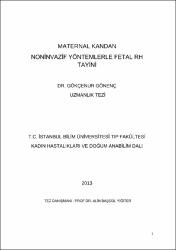Maternal kandan noninvazif yöntemlerle fetal Rh tayini
Künye
Gönenç, Gökçenur. (2013). Maternal Kandan Noninvazif Yöntemlerle Fetal Rh Tayini. Yayımlanmamış doktora tezi. İstanbul : İstanbul Bilim Üniversitesi, Tıp Fakültesi.Özet
Amaç: Bu çalışmanın amacı Rh uygunsuzluğu olan gebelerde fetal Rh durumunun invaziv olmayan bir teknikle, maternal kandan serbest fetal DNA izolasyonu ile tespit edilmesidir. Özellikle daha önceki gebeliklerinde fetal anemi gelişen gebelerde fetusun RhD pozitif olduğunun bilinmesi fetusun yakın takibine olanak verecektir.
Yöntem: Rh uygunsuzluğu olan 50 gebeden serbest fetal DNA izolasyonu yapıldı. İzole edilen DNA, TaqMan probu ve RhD geninin exon 7 bölgesine ait primerlerle Real Time PCR kullanılarak analiz edildi.
Bulgular: Rh uygunsuzluğu olan 50 hastanın 3 tanesinin bebeği RhD negatif olarak saptandı, geri kalan 47 hastanın bebeği RhD pozitif olarak bulundu. RhD pozitif bulunan fetuslardan bir tanesinin, doğumdan sonra RhD negatif olduğu saptandı.
Sonuç: Fetal Rh durumunun non invazif olarak maternal kandan izolasyonu mümkündür. Non invazif olarak fetal RhD durumunun saptanması, gereksiz indirekt coombs testleri ve gereksiz Anti D immunglobulin uygulamasının önüne geçerek maliyet düşürülmesine ve gereksiz kan ürünü uygulamasının engellenmesine olanak sağlayacaktır. Bu çalışma prenatal tanı alanında yeni gelişmelere ön ayak olacaktır. Objective: Anti D Immunoglobulin is applied to all pregnant women having RHD incompability to prevent hemolytic disease of the newborn. The aim of this study is to determine fetal RhD status in the Rh incompatible pregnancies with an non-invasive technique; free fetal DNA isolation from maternal circulation. In the case of Rh incompability especially with a history of previous fetal anemia, it can be beneficial to know Rh status antenatally in terms of monitoring fetuses with Rh positive status consciously.
Methods: Total free DNA was isolated in 50 Rh (-) pregnant women, who had RhD alloimmunisation with their husbands. The gene in isolated DNA is investigated with TaqMan prob and real time PCR by using primers belonging to exon 7 of the RhD gene.
Results: We analyzed 50 RhD negative women by using quantitative real time PCR technique. Three of them were RhD (-) and the rest of them were found to be RhD (+). After birth one of the infants who were analyzed as RhD (+) were found to be RhD(-).
Conclusion: The detection of fetal RhD status by using a noninvasize method from maternal circulation is found to be possible. Assessing fetal RhD status non invasively by using free fetal DNA in maternal blood will be money saving for unnecessary indirect coombs test and unnecessary Anti D immunglobuline applications that is used in RH incompatible pregnancies. This study will throw a fresh light on prenatal diagnosis


















